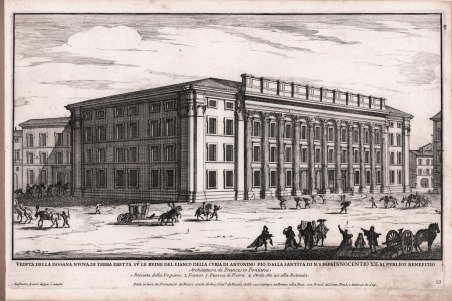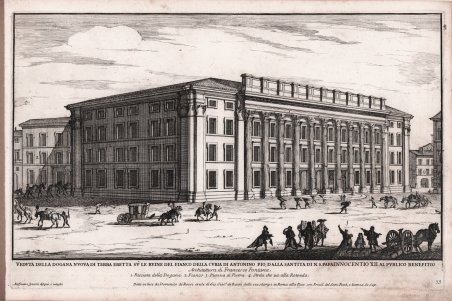Détails
Graveurs
SPECCHI Alessandro
Description
Tratta da Il quarto libro del nuovo teatro dei palazzi in prospettiva di Roma moderna, pubblicato da Domenico de Rossi nel 1699, come quarto libro a completamento del Il nuovo teatro delle fabriche, et edificii, in prospettiva di Roma moderna. Libro primo (secondo, terzo) di Giovan Battista Falda (G. Giacomo de Rossi, 1665-1669). Una delle più belle raccolte di tavole sulla Roma barocca, alla cui rappresentazione si accompagna un intento celebrativo della politica papale. L'opera, infatti, aveva lo scopo di divulgare la nuova immagine della città, con le sue chiese e i suoi palazzi. Dopo la morte di Giovanni Battista Falda (1643-1678) e per far seguito alla sua celebre opera sulle 'fabbriche', un quarto libro fu curato dall'architetto e incisore romano Alessandro Specchi (1668-1729) per descrivere le imprese edilizie volute da Innocenzo XII Pignatelli. A differenza di quelle di Falda, queste sono incisioni che inseriscono gli edifici nel loro contesto cittadino in modo che non solo ne raccontano la struttura architettonica ma – con uno scenario di carrozze e cavalli, servi e padroni, bottegai e garzoni – ne suggeriscono anche l'uso sociale. Vengono così fuori una serie di quadri della città che anticipano le caratteristiche vedute settecentesche. Acquaforte, in buono stato di conservazione. View taken from Il quarto libro del nuovo teatro dei palazzi in prospettiva di Roma moderna, published by Domenico de Rossi in 1699, as the fourth book to complete Il nuovo teatro delle fabriche, et edificii, in prospettiva di Roma moderna. Book one (second, third) by Giovan Battista Falda (G. Giacomo de Rossi, 1665-1669). One of the most beautiful collections of plates on Baroque Rome, whose representation is accompanied by a celebratory intent of papal policy. The work, in fact, was intended to disseminate the new image of the city, with its churches and palaces. After the death of Giovanni Battista Falda (1643-1678) and to follow up his famous work on the 'fabbriche', a fourth book was edited by the Roman architect and engraver Alessandro Specchi (1668-1729) to describe the building enterprises commissioned by Innocent XII Pignatelli. Unlike Falda's engravings, these are engravings that place the buildings in their urban context in such a way that they not only describe their architectural structure but - with a scenario of carriages and horses, servants and masters, shopkeepers and servants - also suggest their social use. The result is a series of pictures of the city that anticipate the characteristic eighteenth-century views. Etching, in very good condition. Cfr.


Découvrez comment utiliser
Découvrez comment utiliser

